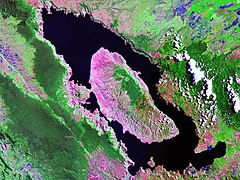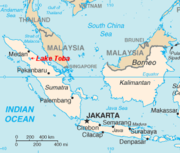Lake Toba
From Wikipedia, the free encyclopedia
| Lake Toba | |
|---|---|
|
|
|
| Location | North Sumatra, Indonesia |
| Coordinates | Coordinates: |
| Lake type | Volcanic/ tectonic |
| Primary outflows | Asahan River |
| Basin countries | Indonesia |
| Max. length | 100 km (62 mi) |
| Max. width | 30 km (19 mi) |
| Surface area | 1,130 km2 (440 sq mi) |
| Max. depth | 505 m (1,660 ft)[1] |
| Water volume | 240 km3 (58 cu mi) |
| Surface elevation | 905 m (2,970 ft) |
| Islands | Samosir |
| References | [1] |
Lake Toba (Indonesian: Danau Toba) is a lake and supervolcano, 100 kilometres long and 30 kilometres wide, and 505 metres (1,666 ft) at its deepest point. Located in the middle of the northern part of the Indonesian island of Sumatra with a surface elevation of about 900 m (3,000 ft), the lake stretches from to . It is the largest volcanic lake in the world.[1] In addition, it is the site of a supervolcanic eruption that occurred 75,000 years before the present, a massive climate-changing event. The eruption is believed to have a VEI intensity of 8. This eruption, believed to have been the largest anywhere on Earth in the last 25 million years, may have had global catastrophic consequences; some scientists believe that this eruption may have wiped out much of humanity and may have created a population bottleneck that affected the genetic inheritance of all human survivors.
Contents |
[edit] Geology
The Toba caldera complex in Northern Sumatra, Indonesia consists of four overlapping volcanic craters that adjoin the Sumatran "volcanic front". The youngest and fourth caldera is the world’s largest Quarternary caldera (100 by 30 kilometres) and intercepts the three older calderas. An estimate of 2500-3000 cubic kilometres of dense-rock equivalent pyroclastic material, nicknamed the Youngest Toba tuff, was blasted from the youngest caldera during one of the largest single eruptions in geologic history. Following the "Youngest Toba tuff eruption", a typical resurgent dome formed within the new caldera, joining two half-domes separated by a longitudinal graben.[2]
There are at least four cones, four stratovolcanoes and three craters visible in the lake.[3]
[edit] The eruption
The Toba eruption (the Toba event) occurred at what is now Lake Toba about 67,500 to 75,500 years ago.[4] It had an estimated Volcanic Explosivity Index of 8 (described as "mega-colossal"), making it possibly the largest explosive volcanic eruption within the last twenty-five million years having a volume 3000 cubic km greater than the Island Park Caldera supereruption (2500 cubic km) of 2.1 million years BP.
Bill Rose and Craig Chesner of Michigan Technological University have deduced that the total amount of erupted material was about 2800 cubic km (670 cubic miles)[5] — around 2000 cubic km of ignimbrite that flowed over the ground, and around 800 cubic km that fell as ash, with the wind blowing most of it to the west. The pyroclastic flows of the eruption destroyed an area of 20,000 square km (7700 square miles), with ash deposits as thick as 600 metres (2000 feet) by the main vent.[5] By contrast, the 1980 eruption of Mount St. Helens ejected around 1.2 cubic km of material, whilst the largest volcanic eruption in historic times, at Mount Tambora in 1815, emitted the equivalent of around 100 cubic km of dense rock and created the "Year Without a Summer" as far away as North America.[6] The eruption was also about three times the size of the latest Yellowstone eruption of Lava Creek 630,000 years ago.[7]
The Toba eruption was the latest of a series of at least three caldera-forming eruptions which have occurred at the volcano. Earlier calderas were formed around 700,000 and 840,000 years ago.[8]
To give an idea of its magnitude, consider that although the eruption took place in Indonesia, it deposited an ash layer approximately 15 cm (6 inch) thick over the entire Indian subcontinent; at one site in central India, the Toba ash layer today is up to 6 m (20 ft) thick[9] and parts of Malaysia were covered with 9 m of ashfall.[10] In addition it has been calculated that 1010 metric tons of sulphuric acid was ejected into the atmosphere by the event, causing acid rain fallout.[11]

The subsequent collapse formed a caldera that, after filling with water, created Lake Toba. The island in the center of the lake is formed by a resurgent dome.
Though the year may never be precisely determined, the season can: only the summer monsoon could have deposited Toba ashfall in the South China Sea, implying that the eruption took place sometime during the northern summer.[12] The eruption lasted perhaps two weeks, but the ensuing "volcanic winter" resulted in a decrease in average global temperatures by 3 to 3.5 degrees Celsius for several years. Greenland ice cores record a pulse of starkly reduced levels of organic carbon sequestration. Very few plants or animals in southeast Asia would have survived, and it is possible that the eruption caused a planet-wide die-off. There is some evidence, based on mitochondrial DNA, that the human race may have passed through a genetic bottleneck within this timeframe, reducing genetic diversity below what would be expected from the age of the species. According to the Toba catastrophe theory proposed by Stanley H. Ambrose of the University of Illinois at Urbana-Champaign in 1998, human populations may have been reduced to only a few tens of thousands of individuals by the Toba eruption.[13]
[edit] More recent activity
Smaller eruptions have occurred at Toba since. The small cone of Pusukbukit has formed on the southwestern margin of the caldera and lava domes. The most recent eruption may have been at Tandukbenua on the northwestern caldera edge, since the present lack of vegetation could be due to an eruption within the last few hundred years.[14]
Some parts of the caldera have experienced uplift due to partial refilling of the magma chamber, for example pushing Samosir Island and the Uluan Peninsula above the surface of the lake. The lake sediments on Samosir Island show that it has been uplifted by at least 450 metres[8] since the cataclysmic eruption. Such uplifts are common in very large calderas, apparently due to the upward pressure of unerupted magma. Toba is probably the largest resurgent caldera on Earth. Large earthquakes have occurred in the vicinity of the volcano more recently, notably in 1987 along the southern shore of the lake at a depth of 11 km.[15] Other earthquakes have occurred in the area in 1892, 1916, and 1920-1922.[8]
Lake Toba lies near a fault line which runs along the centre of Sumatra called the Sumatra Fracture Zone.[8] The volcanoes of Sumatra and Java are part of the Sunda Arc, a result of the northeasterly movement of the Indo-Australian Plate which is sliding under the eastward-moving Eurasian Plate. The subduction zone in this area is very active: the seabed near the west coast of Sumatra has had several major earthquakes since 1995, including the 9.3 2004 Indian Ocean Earthquake and the 8.7 2005 Sumatra earthquake, the epicenters of which were around 300 km from Toba.
On September 12, 2007, a magnitude 8.4 Earthquake shook the ground by Sumatra and was felt in the Indonesian capital, Jakarta. The epicenter for this earthquake was not as close as the previous two earthquakes, but it was in the same vicinity.
[edit] People
Most of the people who live around Lake Toba are ethnically Bataks. Traditional Batak houses are noted for their distinctive roofs (which curve upwards at each end, as a boat's hull does) and their colorful decor.[16]
[edit] Flora and fauna
Lake Toba offers a nurturing environment for fish such as the tilapia mossambica, aplocheilus pachax, lebistes reticulatus, osphronemus goramy, trichogaster trichopterus, channa striata, chana gachua, clarias batrachus, clarias nieuhofi, clarias. sp., nemachilus fasciatus, cyprinus carpio, puntius javanicus, puntius binotatus, osteochilus nasselti, lissochilus sp., labeobarbus sora, and rasbora sp.[17]
Many other types of plants and animals live within the boundaries of Lake Toba. Flora organisms include various types of phytoplankton, emerged macrophytes, floating macrophytes, and submerged macrophytes. Fauna include several variations of zooplankton and benthos.[17]
[edit] See also
[edit] References
[edit] Notes
- ^ a b c Worldlakes.org
- ^ Chesner, C.A., Westgate, J.A., Rose, W.I., Drake, R., Deino, A. (March 1991). "Eruptive history of Earth's largest Quarternary caldera (Toba, Indonesia)". Michigan Technological University. http://www.geo.mtu.edu/~raman/papers/ChesnerGeology.pdf. Retrieved on 2008-08-23.
- ^ "Synonyms and Subfeatures: Toba". Global Volcanism Program. Smithsonian Institution. http://www.volcano.si.edu/world/volcano.cfm?vnum=0601-09=&volpage=synsub. Retrieved on December 13, 2008.
- ^ Zielinski, G. A.; P.A. Mayewski, L.D. Meeker, S. Whitlow, M. Twickler and K. Taylor (1996). "Potential Atmospheric impact of the Toba mega-eruption ~71,000 years ago". Geophysical Research Letters (United States: American Geophysical Union) 23 (8): 837–840. doi:.
- ^ a b "Supersized eruptions are all the rage!". USGS. http://hvo.wr.usgs.gov/volcanowatch/2005/05_04_28.html.
- ^ "Facts about the year without a summer". Discovery Channel UK. http://www.discoverychannel.co.uk/earth/year_without_summer/facts/index.shtml.
- ^ "Supervolcano - The 1,080-square-mile (2,800 km2) Toba caldera is the only supervolcano in existence that can be described as Yellowstone's "big" sister.". Discovery Channel. http://dsc.discovery.com/convergence/supervolcano/others/others_02.html.
- ^ a b c d "Toba, Sumatra, Indonesia". Oregon State University. http://volcano.und.nodak.edu/vwdocs/volc_images/southeast_asia/indonesia/toba.html.]
- ^ Acharyya S.K., and Basu P.K. 1992. "Toba ash on the Indian subcontinent and its implications for correlation of late pleistocene alluvium." Quaternary Research 40:10-19
- ^ Scrivenor, J.B. 1931. The Geology of Malaya (London: MacMillan), noted by Weber.
- ^ Huang C.Y., Zhao M.X., Wang C.C., and Wei G.J. 2001. "Cooling of the South China Sea by the Toba eruption and correlation with other climate proxies ca. 71,000 years ago." Geophysical Research Letters 28:3915-3918, noted by Weber.
- ^ Bühring C., and Sarnthein M. 2000. "Toba ash layers in the South China Sea: evidence of contrasting wind directions during eruption ca. 74 ka." Geology 28:275-278.
- ^ "Yellowstone Is a Supervolcano?" (HTML). SEMP. http://www.semp.us/publications/biot_reader.php?BiotID=164. Retrieved on 2008-02-21.
- ^ "Toba volcano (Indonesia, Sumatra)". VolcanoDiscovery.com. http://www.volcanodiscovery.com/volcano-tours/volcanoes/indonesia/sumatra/toba/.
- ^ "Significant Earthquakes of the World". United States Geological Survey (USGS). http://earthquake.usgs.gov/eqcenter/eqarchives/significant/sig_1987.php.
- ^ "Batak People". IndonesianMusic.com. http://www.indonesianmusic.com/batak.htm.
- ^ a b "Danau Toba (Lake Toba)". International Lake Environment Committee. http://www.ilec.or.jp/database/asi/asi-10.html.
[edit] Sources
- Rampino, Michael R. and Stephen Self (1993). "Climate-volcanism feedback and the Toba eruption of 74,000 Years Ago". Quaternary Research 40 (3): 269–280. doi:.
- Vazquez, Jorge A. and Mary R. Reid (2004). "Probing the accumulation history of the voluminous Toba Magma". Science 305 (5686): 991–994. doi:.
- Petraglia, M. et al. (2007). "Middle Paleolithic Assemblages from the Indian Subcontinent Before and After the Toba Super-Eruption". Science 317 (5834): 114–116. doi:.
[edit] External links
- Toba, Sumatra, Indonesia - Volcano.umd.edu Accessed 11 December 2005
- Stanley H. Ambrose, Volcanic Winter, and Differentiation of Modern Humans Accessed 11 December 2005
- Joel Achenbach, Who Knew, National Geographic Accessed 11 December 2005
- George Weber, Toba Volcano
- Lake Toba travel guide from Wikitravel






